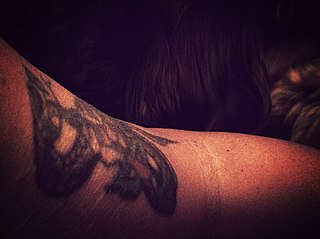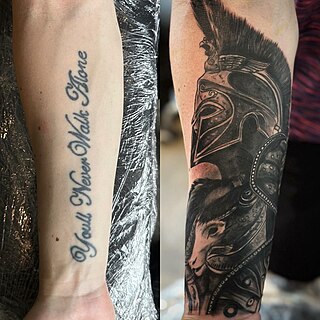Dermatology is the branch of medicine dealing with the skin. It is a speciality with both medical and surgical aspects. A dermatologist is a specialist medical doctor who manages diseases related to skin, hair, nails, and some cosmetic problems.

A scar is an area of fibrous tissue that replaces normal skin after an injury. Scars result from the biological process of wound repair in the skin, as well as in other organs, and tissues of the body. Thus, scarring is a natural part of the healing process. With the exception of very minor lesions, every wound results in some degree of scarring. An exception to this are animals with complete regeneration, which regrow tissue without scar formation.

A medical tattoo is a tattoo used to treat a condition, communicate medical information, or mark a body location for treatment. People may get a paramedical tattoo to conceal a condition or the effects of treatment, such as creating the appearance of an areola after breast reconstruction, or a cover-up tattoo to disguise the area in an artistic way.

Rosacea is a long-term skin condition that typically affects the face. It results in redness, pimples, swelling, and small and superficial dilated blood vessels. Often, the nose, cheeks, forehead, and chin are most involved. A red, enlarged nose may occur in severe disease, a condition known as rhinophyma.

A port-wine stain is a discoloration of the human skin caused by a vascular anomaly. They are so named for their coloration, which is similar in color to port wine, a fortified red wine from Portugal.
Dermabrasion is a type of surgical skin planing, generally with the goal of removing acne, scarring and other skin or tissue irregularities, typically performed in a professional medical setting by a dermatologist or plastic surgeon trained specifically in this procedure. Dermabrasion has been practiced for many years and involves the controlled deeper abrasion of the upper to mid layers of the skin with any variety of strong abrasive devices including a wire brush, diamond wheel or fraise, sterilized sandpaper, salt crystals or other mechanical means.

A concealer or color corrector is a type of cosmetic that is used to mask imperfections on the skin. These imperfections can include dark circles under the eyes, blemishes, and hyperpigmentation. Concealer is similar to, and can be used in conjunction with foundation, a lighter cosmetic that is used to even out the skin tone. Both concealer and foundation are typically used to make skin appear smoother and more uniform in color. These two types of cosmetics differ in that concealers tend to be more heavily pigmented, though concealer and foundation are both available in a wide range of colors and opacities.

Permanent makeup, also known as permanent cosmetics, derma-pigmentation, micro-pigmentation, semi-permanent makeup and cosmetic tattooing, is a cosmetic technique which employs tattooing techniques to replicate the appearance of traditional makeup. By implanting pigments into the dermis, long-lasting designs are created such as eye liner, eyebrows, and lip color. This procedure appeals to a diverse range of people; from those who want to make their daily routines more simple to individuals with medical conditions. By eliminating the need to apply traditional makeup regularly, permanent makeup has become a very convenient and effective solution. More than an aesthetic technique, permanent makeup plays a crucial role in procedures of reconstructive type.

Perioral dermatitis, also known as periorificial dermatitis, is a common type of inflammatory skin rash. Symptoms include multiple small (1–2 mm) bumps and blisters sometimes with background redness and scale, localized to the skin around the mouth and nostrils. Less commonly, the eyes and genitalia may be involved. It can be persistent or recurring, and resembles particularly rosacea and to some extent acne and allergic dermatitis. The term "dermatitis" is a misnomer because this is not an eczematous process.

Tattoo removal is the process of removing an unwanted tattoo. The process of tattooing generally creates permanent markings in the skin, but people have attempted many methods to try to hide or destroy tattoos.
A chemical peel is a treatment used to improve and smooth the texture of the skin. The skin on the face is most commonly treated, but peels can also be performed on the body. Chemical peels are intended to remove the outermost layers of the skin. To accomplish this task, the chosen peel solution induces a controlled injury to the skin, which causes the skin to peel. This process leads to smoother skin can improve fine lines, acne scars, and pigment. Medium depth peels must be performed by a medical provider.

The history of cosmetics spans at least 7,000 years and is present in almost every society on earth. Cosmetic body art is argued to have been the earliest form of a ritual in human culture. The evidence for this comes in the form of utilised red mineral pigments including crayons associated with the emergence of Homo sapiens in Africa. Cosmetics are mentioned in the Old Testament—2 Kings 9:30 where Jezebel painted her eyelids—approximately 840 BC—and the book of Esther describes various beauty treatments as well.

Cover-up tattoos are those done over one or more previous tattoos, scars, or skin conditions.
Madarosis is a condition that results in the loss of eyelashes, and sometimes eyebrows. The term "madarosis" is derived from the ancient Greek "madaros", meaning "bald". Eyelashes are important in the prevention of bacteria and other foreign objects entering the eye. Some studies found that between 45 and 76 percent of patients with various types of leprosy had madarosis.

A pimple or zit is a kind of comedo that results from excess sebum and dead skin cells getting trapped in the pores of the skin. In its aggravated state, it may evolve into a pustule or papule. Pimples can be treated by acne medications, antibiotics, and anti-inflammatories prescribed by a physician, or various over the counter remedies purchased at a pharmacy.
Aesthetic medicine is a branch of modern medicine that focuses on altering natural or acquired unwanted appearance through the treatment of conditions including scars, skin laxity, wrinkles, moles, liver spots, excess fat, cellulite, unwanted hair, skin discoloration, spider veins and or any unwanted externally visible appearance. Traditionally, it includes dermatology, oral and maxillofacial surgery, reconstructive surgery and plastic surgery, surgical procedures, non-surgical procedures, and a combination of both. Aesthetic medicine procedures are usually elective. There is a long history of aesthetic medicine procedures, dating back to many notable cases in the 19th century, though techniques have developed much since then.
Azeezia Medical College Hospital is a private hospital located in Kerala. It is a 540-bed multi-specialty hospital. The hospital provides treatment in various specialties, such as medicine, surgery, obstetrics and gynecology, dermatology, psychiatry, pediatrics, orthopedics, ophthalmology, otolaryngology, anesthesiology, radiology, emergency services, and laparoscopic surgery. Super-specialty departments include cardiothoracic, neurology, nephrology, pulmonology, gastroenterology, endocrinology, and neurosurgery. The private medical college includes super-specialty units and colleges for medical, dental, and nursing courses. The campus is in a rural area eight km (5.0 mi) from NH-47.

Yoram Harth is an Israeli dermatologist and inventor. He co-invented blue light acne vulgaris phototherapy, as well as a radio frequency device for home treatment for wrinkle reduction.
A visible difference refers to a physical characteristic, such as a scar, mark, disfigurement, or condition on the face or body that distinguishes an individual from what is conventionally considered to be the societal norm. These visible differences can arise due to a multitude of factors including but not limited to congenital conditions, accidents, diseases, or surgical procedures. Such differences often carry significant psychological, social, and sometimes physical implications for the affected individual.
Tina S. Alster, MD, FAAD, is an American dermatologist, educator, researcher, and author. Alster specializes in dermatologic laser surgery and cosmetic dermatology. She is the founding director of her skin care clinic, the Washington Institute of Dermatologic Laser Surgery, and is a Clinical Professor of Dermatology at Georgetown University Medical Center in Washington, D.C.











